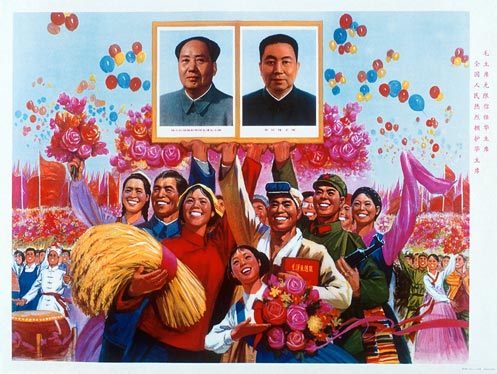
1976 - Chairman Mao trusted Chairman Hua completely
Acknowledgements: This series would never have been possible without the two websites listed beneath. These are the kinds of sites that really make me love the Internet. If you enjoy what you've seen in these posts, spending a few hours (or days) exploring these websites is not a bad way of spending your time
Chineseposters.net - Hosted and designed by the International Institute of Social History in Amsterdam, this website presents the poster collections of the IISH and that of Stefan R. Landsberger. Landsberger is the editor of this utterly fascinating site, which he runs together with co-editor Marien van der Heijden.
It includes a vast collection of imagery, accompanied by a wealth of well written commentary and discussion, putting the imagery in the right context, and I've drawn much on it in the writing of these posts.
Maopost.com - Another huge collection of propaganda. Not as much commentary as in the former, but including an online collection of over 1600 posters in good quality. For those who get hooked on this stuff and have a few hundred dollars to spend, Maopost offers hand painted copies of a selection of posters where you can get a face of your choice (including your own) painted into an otherwise authentic poster.
The change of leadership that occurred after the deaths of Mao and Zhou Enlai in 1976 set the People's Republic on a different path than what its first generation leaders had advocated. It took some years to become apparent, but as it turned out, the path was no longer a path, but a railroad, accommodating a billion ton economic boom locomotive, built out of coal and steel, cheap t-shirts and rice cookers, semiconductors and space rockets. 422 million Chinese were lifted out of absolute poverty from 1981 to 2001.
Whether it was Deng Xiaoping's economic reforms that did it, or the inevitable result of a long period of peace and the absence of upheavals like the cultural revolution, remains for proper scholars to debate. What can hardly be disputed is that China in the period covered in this post went from a peripheral country of sorts, albeit one with a lot of inhabitants, to a giant which few countries can now afford to ignore.
And if you look at economy in the long historical view, China's rise is nothing more than a return to the norm. As late as 1820, China was responsible for 33% of world economic output, a greater share than that of the United States in the years since World War II. For 18 out of the last 20 centuries, China has had the world's largest economy.

1977 - Boundless confidence
Barely a month after Mao's death, a clique of party members headed by Hua Guofeng seized power, arresting the Gang of four, and elevating Hua as the new Chairman of the People's Republic. With the Gang of Four stripped of their control of the propaganda apparatus, it was time to consolidate Hua's grip on power, and popularize him, as seen in these two posters.
A central part of that campaign was to demonstrate how Mao had wanted Hua as his successor, and show Mao's "boundless" confidence in Hua's abilities and ideological purity. Where a prospective Byzantine Emperor would claim having been "born in the purple" [room of the royal palace, thus being a son of a ruling emperor], Hua Guofeng would have himself portrayed having a friendly meeting with the late Great Leader, illustrating Mao's support of Hua inheriting his power and prestige.
I rather like the contrasts the two posters above present. While both were made for the same purpose, their styles could hardly be less similar. The first poster is an explosive array of smiling people, balloons and all the brightest new colours from China's best colour technology labs. The second poster on the other hand, is mellow with highly restrained use of colours, showing two humble leaders in a modest setting, fit for the leaders of a communist revolution.

1977 - Relentlessly criticize the "Gang of four", set of a new upsurge of industry studying Daqing and agriculture studying Dazhai
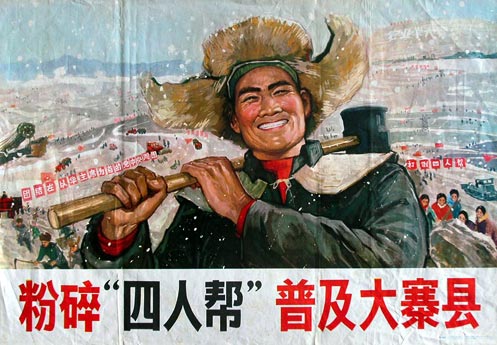
1977 - Smash the Gang of Four and popularize the agricultural experience of Dazhai county
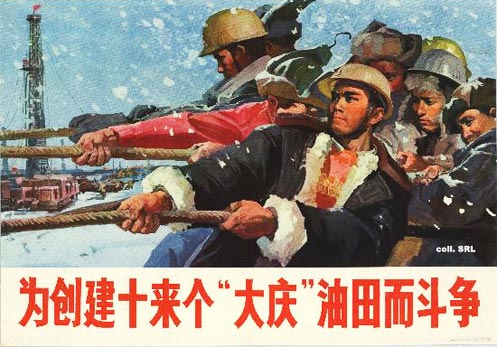
1978 - Struggle to create some ten "Daqing" oil fields
Strange thematic links in these three posters. At first glance, you wonder if the People's Republic might be short on printing presses, and thus decided to combine unrelated messages in their posters. However, considering the vast amounts of posters that were printed, particular in this period, that seems unlikely. Thus, I'm at a loss as to why these combos appeared.
The Gang of Four had been arrested in 1976, but just to be sure that there wasn't any lingering support for them in the populace, it was prudent to launch a public campaign against them. For reasons unbeknownst to me, this was coupled with promotions of the by now familiar model towns of Daqing and Dazhai.
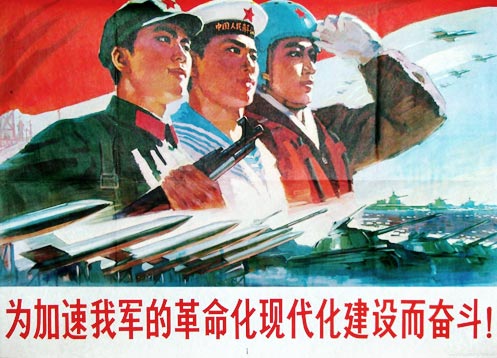
1977 - Strive to accelerate the revolutionization and modernization of our army
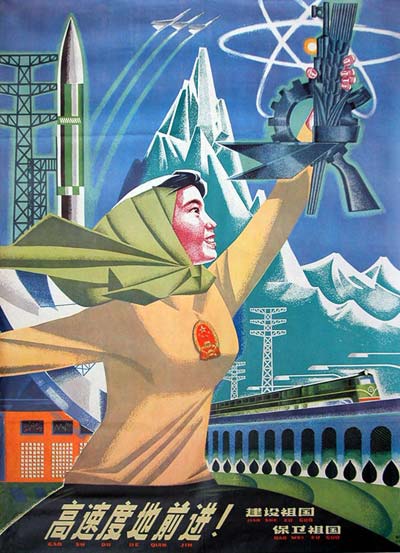
1978 - Move fast forward! Construct and protect the Motherland
The first of these posters looks like your average, somewhat pompous military propaganda poster, but how about the second one?! Ain't that wonderful or what? With its Art Deco inspired style, it's definitely a break with the more naturalistic styles usually found, such as in the first of these two posters. In my head, communism has always been intimately connected with modern industry, machines and the straight and smooth shapes it comes in, so this particular poster is communist through and through in my head.
In earnest, that doesn't really make a good fit with the communist China of these times, since it's not until recent decades that China has diversified away from its great reliance on agriculture. While, as we've seen, many calls for industrializations have been made throughout the history of the People's Republic, by 1978, it was still an overwhelmingly rural, agricultural society. Mao's Great Leap Forward did little good, if anything at all, to change that.
However, it was around this time things started to change. Mao's death and the coup that followed signaled the end of the upheavals of the Great Leader's experiments, and put more pragmatic people in charge. Hua was the new guy at the top, but he would eventually be pushed out of power by men like Deng Xiaoping. Deng, as you may remember, had been purged and denounced over and over, but had managed to stay alive, and now led China in a more market oriented, economically managed direction. "Made in China" would become an ever more common label.
A curious detail in the second poster is the torch-like object the woman is holding, a combination of a cog, some sort of cereal and an AK-47, all done to an immaculate steel finish.
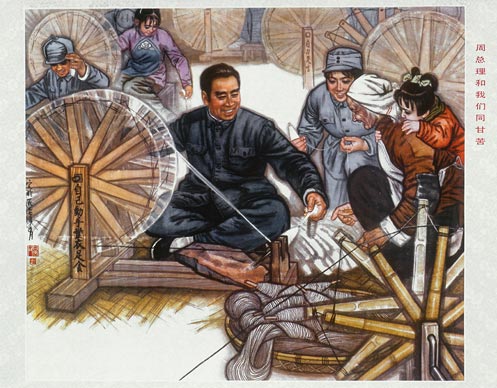
1978 - Premier Zhou shares our happiness and hardship
While the People's Republic has never been democratic as such, it's nevertheless a far cry from the absolutist regimes of for instance the Russian Tsars, or Stalin for that matter, as evidenced by this poster. Whereas a tsar would distance himself from his subjects and take pride in this elevated status, the recently deceased Premier Zhou Enlai is seen here sharing the daily routines of his comrades. While doing that, he's dressed as plainly as his fellow party members; no gold, no tassels, no sash or silly hat, just a simple Sun Yat-sen suit, inspired by the forefather of the modern republican China.
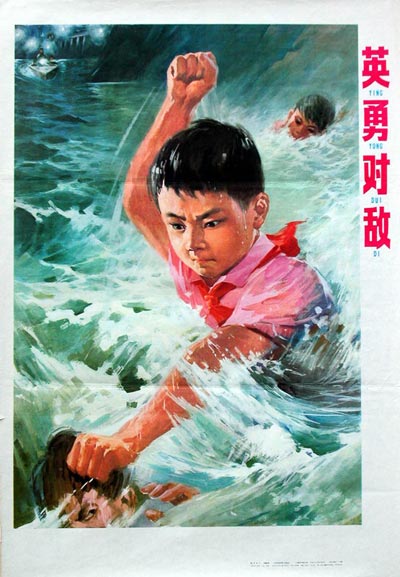
1979 - Face the enemy courageously
Downright horrid. There may be some background story to this poster that could explain its depiction of a young boy beating someone to death, but lacking such, it's just terrifying and nasty in my eyes. The artistic qualities are on par with everything else here though.
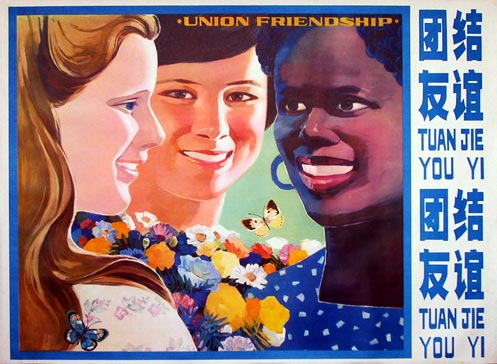
1979 - Union friendship
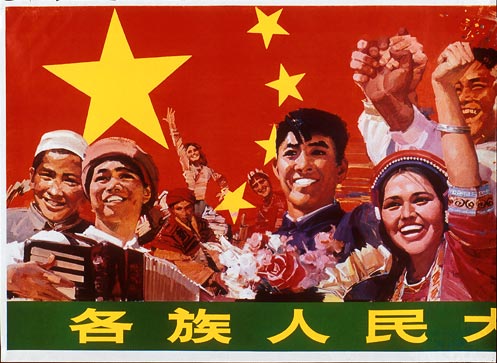
1979 - Long live all the nationalities united as one people
Oh Solidarity! I've mentioned earlier in the series that I'm something of a sucker for these posters promoting international solidarity, and the first of these posters in particular has the added charm of reminding me of a milk carton. It's probably the combination of light colours and a good deal of white and blue that does the trick for me. I can hardly imagine anything more friendly than a milk carton, though vegans and people with lactose intolerance might object. Regardless, both posters do a nice job illustrating the unity of the people of the world, under Chinese leadership, as the second poster demonstrates.
After Mao's death and the onset of more pragmatic leadership in the People's Republic, the country started loosing much of the goodwill and foreign support it had amongst communist regimes and groups abroad. Without the bold ideological proclamations of Mao to present visions of the future, the People's Republic turned into just another country, working to achieve its own national goals, rather than leading all humanity to the socialist paradise.
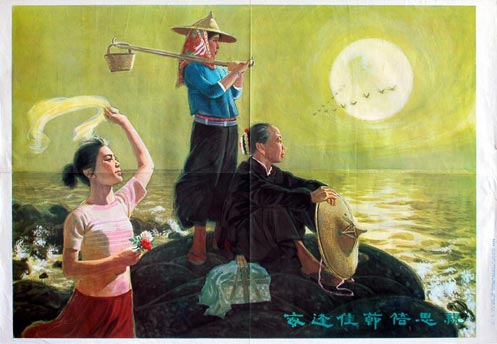
1980 - On festive occasions, one thinks more than ever of those close to one's heart
After what we've seen so far in this series, this poster seems out of place. It's symptomatic of the changes that came after Mao's death, with more variation in poster themes, and less focus on the traditional communist agendas. There isn't the slightest hint of tractors, oil pumps or Kalashnikovs here.
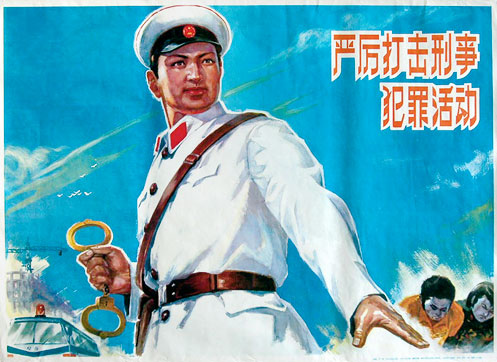
1983 - Crack down hard on criminal activity
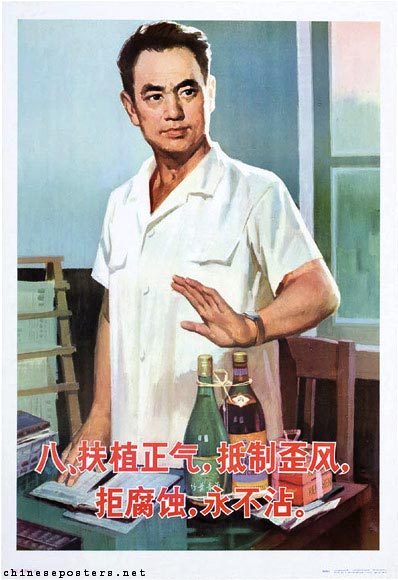
1983 - Foster a correct spirit, resist the evil spirit, resist corruption, never get involved with it
Corruption is a problem which just about any state will go through, and may or may not be able to alleviate. In ancient Rome, what we would call corruption was the order of the day, it was how things worked, whereby people in public office were fully expected to enrich themselves from their offices, and pay other citizens for their support. But with the spread of the modern notion that the state is there to serve its constituent parts, its citizens, and not just the ruling elite, corruption is seen as an evil hindering effective development, justice and equal opportunities for citizens, in terms of education, economic competition and so on.
Shortly put, corruption is not compatible with the common good. If there's anything a proper communist state is supposed to care about, it's the common good. In the People's Republic, corruption had been a problem for a long time, but it was not until the 80's that it was given public attention. I like the mild mannered expression of the incorruptible civil servant in the second poster. In keeping with the first poster, you might expect him to call in the police to "crack down hard" on the unseen villain and send him to a work camp for the rest of his life. Instead, our hero, dressed in a clean white shirt, turns down the offer in a civil, yet firm tone, a true professional.
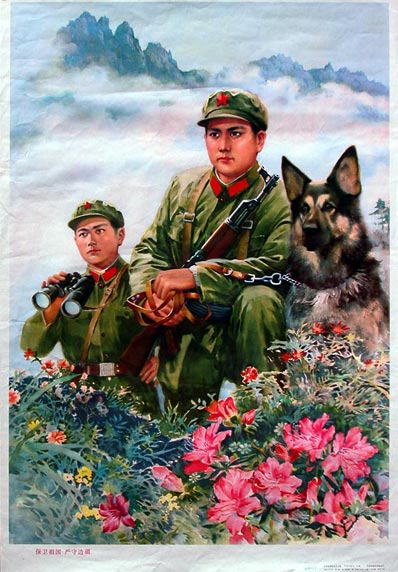
1983 - Protect our Motherland and strictly guard our frontiers
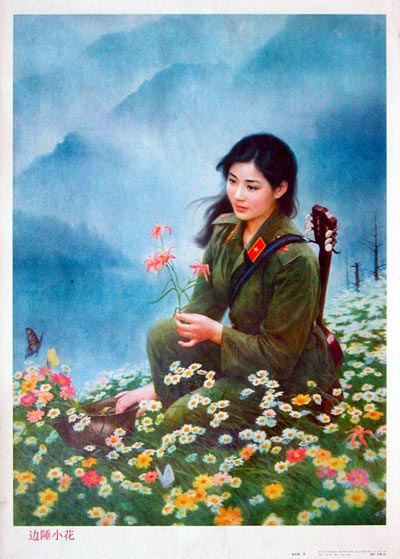
1988 - Small flowers from the border
I get the impression that from the early 1980's, Chinese propaganda posters seem to take on a less aggressive tone. It's not that the determination towards socialism, development and security from threats internal and external has disappeared, but those goals are not the only ones being seen anymore.
The first poster shows a theme you'll remember from the previous two posts, but with two prominent differences. First, our heros are no longer situated in the frozen forests to the north facing Soviet Russia, but rather in some temperate/sub-tropic mountain climate. A likely location could be the mountainous areas along much of the border between Vietnam and the People's Republic, where the two countries had fought a short, bloody and inconclusive war in 1979. Yet again, the global communist conspiracy appears as not quite so unified.
Second, the soldiers in both posters just happen to be hanging about in lovely fields of flowers. While the first poster makes it clear that we are still dealing with a threatening situation, the flowers found in both posters seem to me to imply that it's allright to not focus one's entire, uninterrupted attention towards the defense of the Motherland, but also to enjoy the flowers of the Motherland itself.
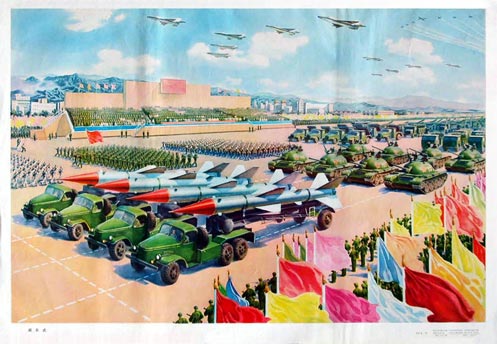
1983 - Trooping the colors
Back to what can perhaps be said to be more conventional fare, this poster illustrates a phenomenon which is closely associated in people's minds with communist regimes, the military parade. Besides the french Bastille Day, it is parades in communist regimes like North Korea, Soviet Russia or the People's Republic that spring to my mind when I see this poster.
Since these parades typically go past a high stand acommodating the country's big boss and his henchmen, it is a big honour to get a place on this stand. In the case of the Soviet Union, in lack of better sources of information on the power games in the party, western researchers, so-called "Kremlinologists", would extrapolate information from May day parade images of who were on the Lenin Mausoleum stand that year, and who were allowed to stand closest to the General Secretary. If someone moved closer to him, the Kremlinologists assumed this person was moving up in the hierarchy, and vice versa.
The General Secretary would always be first to enter the stand, so in 1987, Kremlinologists wondered whether the unusual three second gap between Gorbachev appearing and the next person following, was intended to more clearly demonstrate his superiority to them, or if one of the next guys had simply tripped on the way up.

1984 - To love the country one must first know its history - The deeper the knowledge, the more eager the love
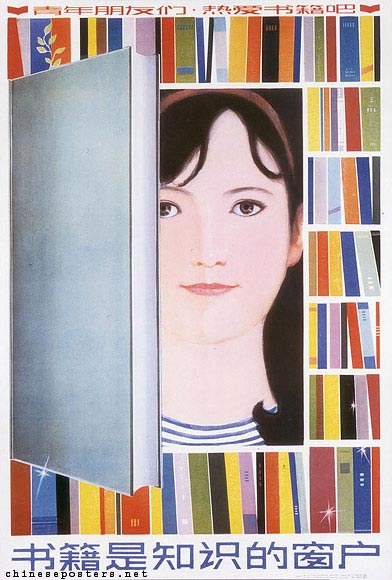
1984 - Books are a window on knowledge
What a change of mentality since the times of Mao stating that "To Read Too Many Books is Harmful" and the Little Red being seen as the only book worthwhile studying, the cure for all problems! The book in the first poster reads as "Modern and Contemporary History of China". I'm not sure if this was an actual book or a symbol of the importance of studying the country's history. In either case, the title suggests clearly another change in mentality that was coming about.
Focus on Chinese nationalism is clearly an absent element in earlier propaganda from the People's Republic, it was the material and ideological upkeep and furthering of the revolution - and eventually the world revolution - which was the central issue, not promoting the love of the Chinese nation in itself. However, having by now spent nearly a third of a century trying to direct world revolution, it still didn't appear imminent, so uniting the Chinese behind the nation of China as opposed to the world revolution seemed a better way to ensure unity and progress.
The second poster is a wonderful one in my eyes, light and bright colours with clean contrasting surfaces, framing a pretty face. I'll admit that while I do like the naturalist/realist look found in most of the posters I've covered, if pressed to choose, I'd probably prefer the more stylized posters, such as this, which seem more prevalent in the Euro-American sphere than in China. It may just be because I am a European, but to me posters like this one just appear more bold and striking with their clear and simple look, forgoing the natural, real-life-imitating look for one which is more eye-catching, at least to my eyes.
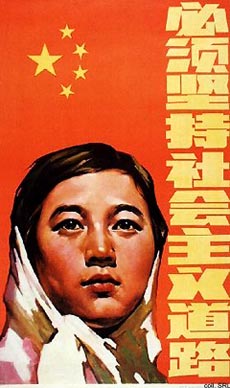
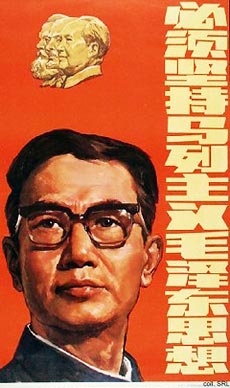
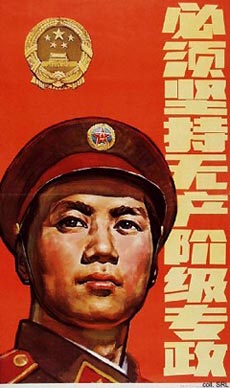

1984 - Deng Xiaoping's four Basic principles:
We must keep to the socialist road
We must uphold the dictatorship of the proletariat
We must uphold the leadership of the Communist Party
We must uphold Marxism-Leninism-Mao Zedong Thought
While the new leadership changed many of the People's Republics priorities and abandoned elements of the Mao-era regime, one must not be deluded into thinking that from the 1980s on, the People's Republic was turning into just another capitalist state. It has certainly become more capitalist than it was, but it's still a socialist state.
This wonderful family of posters then, promotes Deng Xiaoping's "Four Basic Principles" as formulated in 1979, principles which have been included in the constitution of the People's Republic and are still in effect. The first principle (and poster) makes clear that socialism is still the right way ahead, the second and third confirms the legitimacy of the leading communist party, in its less-than-democratic form, while the fourth gives attention to the ideological foundations of state and party.
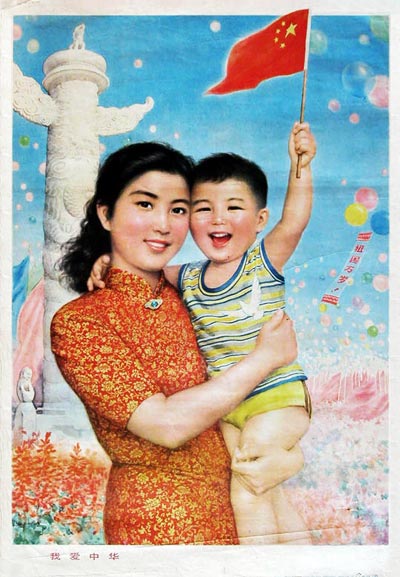
1985 - I love China
If the move towards nationalism suggested in the previous 1984 history book poster wasn't clear enough, then this surely is. China has a value beyond being the top dog among communist states, it is a nation with an ancient culture and thousands of years of history. As this poster suggests, it is a good place to live as well, and thus, should be cherished by its inhabitants.

1986 - Youthful dance steps
With ample energetic lighting and a full size big band providing music, the groundwork seems to be there for a swinging party, but these guys look like they're struggling a bit. This being propaganda, they are of course made out to be overjoyed, but they seem stiff like logs, and their "youthful dance steps" limited to snapping their fingers, possibly in time with the beat. But I suppose that's only to be expected in a country where for a long time, the state declared that discos and the likes were decadent.
Beyond that, this poster illustrates that people were now allowed to have fun, even BEFORE the completion of the revolution, BEFORE the onset of the eternal socialist paradise. The time when one's personal interest was forever set aside by an endless succesion of five year plans and great leaps demanding total dedication and sacrifice, had come to an end.
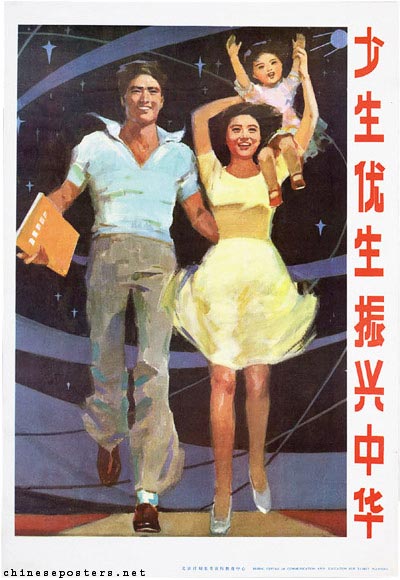
1987 - Fewer births, better births, to develop China vigorously
In effect since 1979, the "One child" policy whereby urban couples, and to some degree rural ones, are in effect banned from having more than one child, is intended to reduce China's massive population growth, and the economic, social and environmental problems which it would cause.
It does, however, give rise to a range of problems on its own. For one thing, the gender disparity is widening in China, which many see as a result of the policy. The "natural" disparity is considered to be 105 boys born for every 100 girls, but in China as of the year 2000, that number was 117 to 100. Furthermore, the somewhat abrupt reduction of birth rates means that as the living generations grow older and become retired/less productive, there will be fewer young and productive people to support them. It's a problem haunting not only China, but also most western countries, with Italy perhaps the best known example.
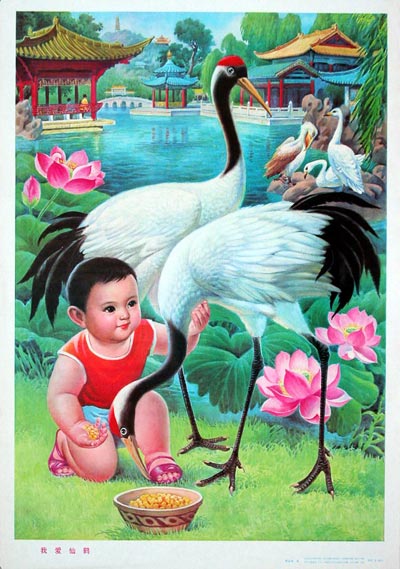
1987 - I love the white crane
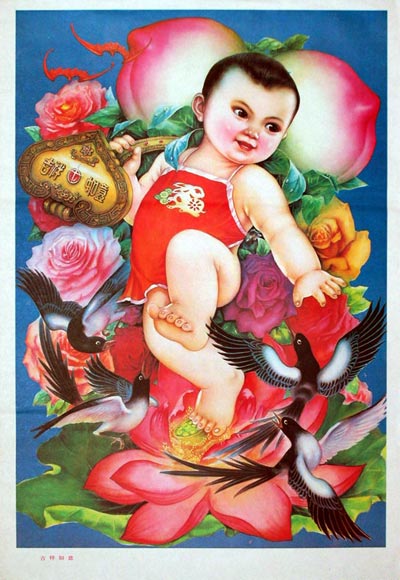
1987 - Wish you good luck
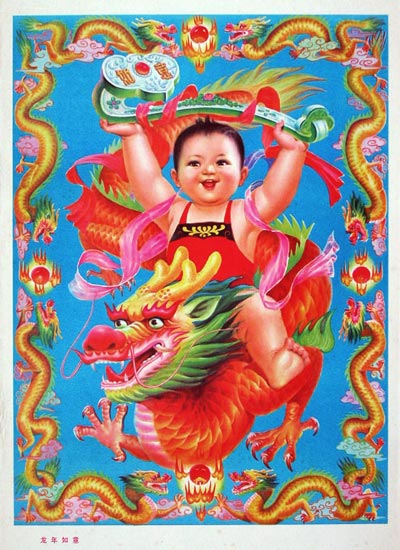
1987 - Wishing you a happy Year of the Dragon
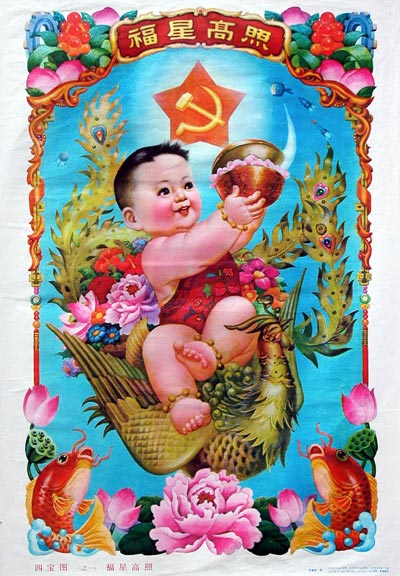
1988 - The 1st poster of Four Treasures - A lucky star shines on high
These are, to me, among the less comprehensible posters in this series. Apparently, posters featuring fat little toddlers are big business in China, a business the communist party has gladly taken, sometimes, but most often not including symbolism to its own support (see the fourth of the posters).
These posters typically show disturbingly chubby babies frolicking with massive crimson carps, dragons or other animals, in newer posters sometimes playing with some modern gadget. They are loaded with symbolism that I as an outsider struggle to take on board, but at least I've learnt that the carps are potent symbols of abundance.
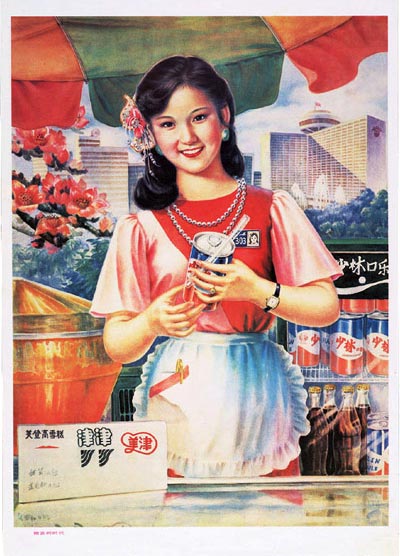
1988 - The age of smiling
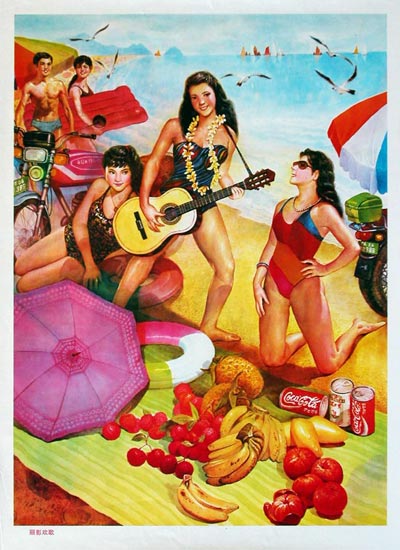
1989 - Beautiful picture, merry song
I rather doubt that these posters are government sanctioned propaganda, rather than advertisements. The first one features suspiciously Pepsi-like cans while the second one quite obviously promotes Coca Cola. It's hard to imagine this being permitted under Mao, nor is the depiction of women here something you'll find much of during that era. If you look back at the depiction of women in earlier posters, they range from tomboys to big burly men with breasts and semi-long hair. As these three posters show, depicting women in a feminine fashion became OK again, they need not necessarily become men to be good socialists.
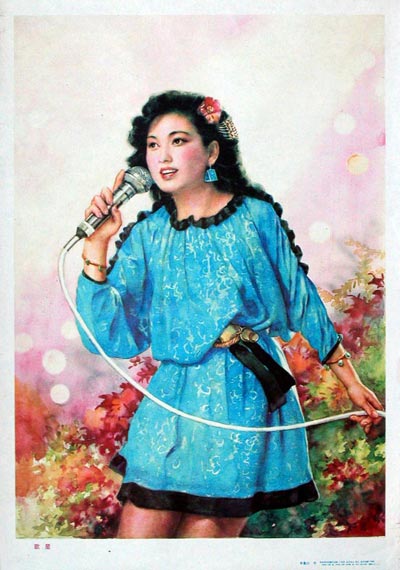
1989 - Pop star
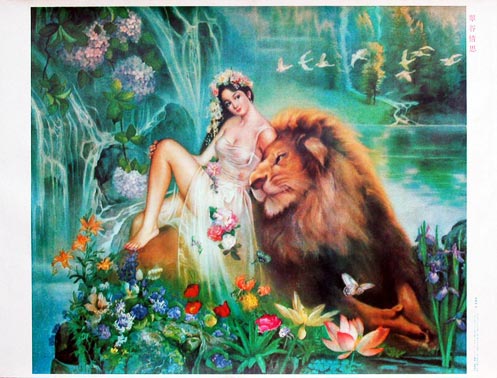
1990 - Green valley love
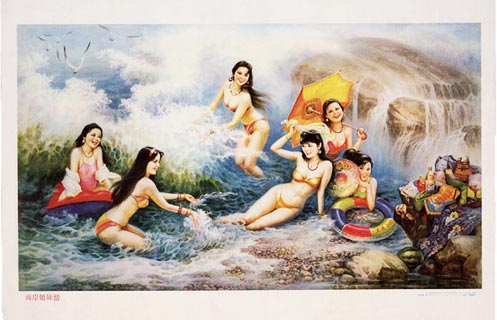
1990 - The feeling of the sisters of the two coasts
With regards to the first two posters, I haven't the slightest idea what they're supposed to promote, or if they are governmental propaganda at all. The second one, the one with the lion, looks more like the depictions of paradise usually presented by Mormons or the likes who come knocking on my door. Throw in a rainbow and a couple of panda's, and there would be no difference. Is it just me or is the lion folding its paws?
While it's not obvious from its looks, the third poster does in fact present a particular theme, it's not just a decoration for a car mechanics' shop. The sisters mentioned in the poster message are the People's Republic of China and the Republic of China, or in other words, mainland China and Taiwan. In part 2, we saw soldiers and civilians with guns pointed across the Taiwan strait, with bomber planes in the air, ready to strike. Such an attack has not occurred so far, and by 1990, the rhetoric was apparently toned down a bit.
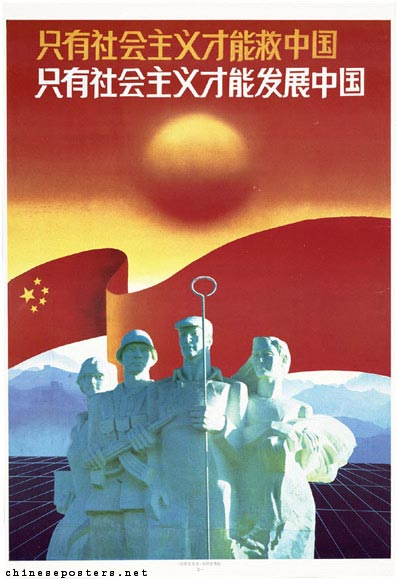
1989 - Only socialism can save China, only socialism can develop China
After the Tiananmen Square massacre on June 4th of that year, the regime urgently needed to reinforce the public view of its legitimacy. This poster goes straight at the throat of the protesters' message. Where the protesters demanded democratic reform, the poster states clearly that there can be but one solution. Where the protesters built a massive 10 meter polystyrene and paper-mâché statue called "Goddess of Democracy" and kept it as a centerpiece on the square, this poster presents the traditional theme of the people unified towards the greater good of all in the form of a statue, apparently from the same materials.
It's quite a hideous poster, springing from a hideous event. The statue itself looks like it's been crudely photographed without any regard to lighting, resulting in some harsh shadows. This photo has then been pasted onto a mishmash of ill-fitting graphics, including a Tron-like surface, some blue awnings, a big red banner and a bloody, murky sun.
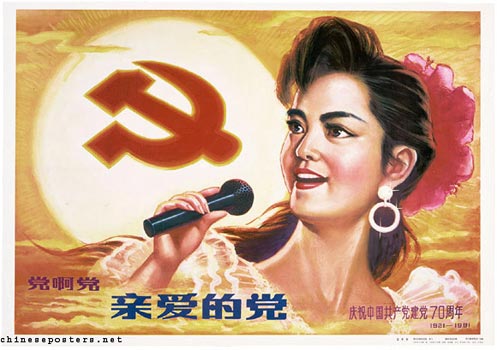
1991 - Party oh party, beloved party
On the occasion of the 70th anniversary of the Chinese Communist party, this girl sings in praise of the party, karaoke style. I rather enjoy the huge hammer-and-sickle covering the sun, as if it's a communist version of the "Bat signal", calling upon the Karaoke-singers of the People's Republic to unite in praise.
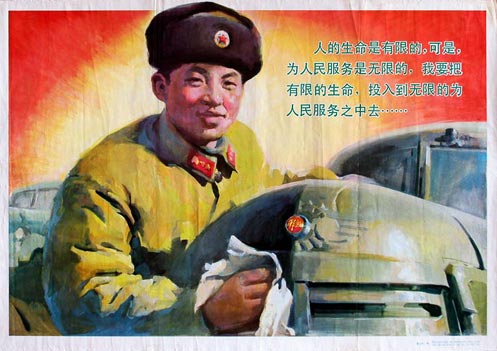
1990 - A human being's life is finite, but serving the people is endless.
I shall use my life to participate in serving the People forever
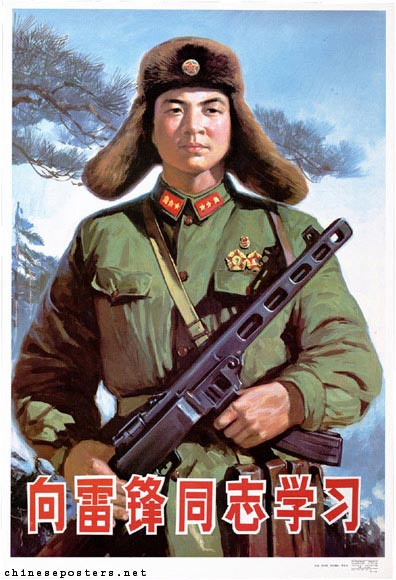
1990 - Study comrade Lei Feng
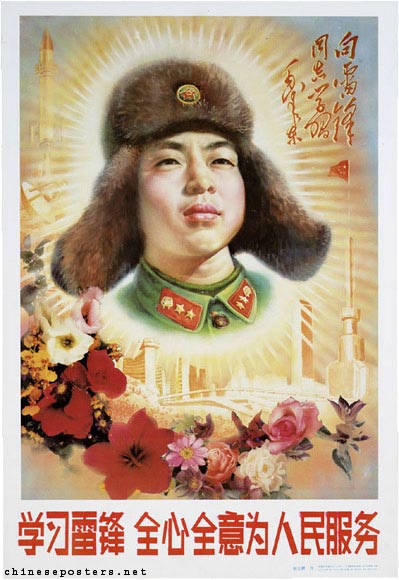
1995 - Study Lei Feng, serve the people wholeheartedly
While the message of the first poster does not directly mention Lei Feng, the fellow with the truck looks much like him in my eyes, and his message certainly fits with what's generally assosciated with the name. Who's Lei Feng, I hear you ask. Well, he was the "revolutionary screw that never rusts", or at least that's what he wanted to be. There's no consensus as to whether Lei Feng ever actually existed. The official story is that he was an orphan, raised by the Communist Party, that turned into the perfect, obedient screw in the machinery that was the People's Republic.
As the first poster suggests, he was all about sacrifice for the better good. He was supposedly killed in August of 1962 when a pole fell on top of him having been backed into by a truck. As of 2003, Lei Feng, in all his ant-like glory, was still seen as a viable model character for the Chinese, more than 40 years after his death.
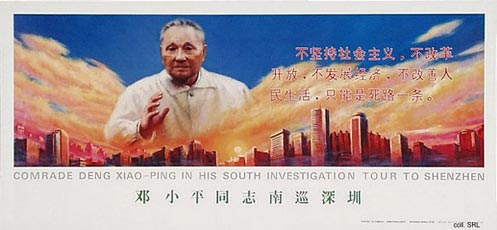
1992 - Comrade Deng Xiaoping in his south investigation tour to Shenzhen
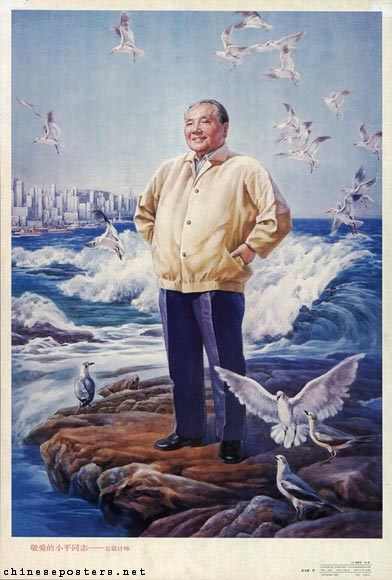
1994 - Beloved comrade Xiaoping
Finally some posters featuring the big man of the last decade and a half. Deng Xiaoping disliked the cult of personalities that had been propagated in the People's Republic, particularly towards Mao. Nor was he partial to seeing himself turned into an idol of worship, and it was not until his retirement from the political scene in 1992 that the propagandists were able to feature him on a significant scale, the ailing revolutionary-turned-reformist no longer able to prevent his person being used as a propaganda symbol. Officially retired since the Tiananmen square massacre (in which he likely played a part), Deng returned to the public view for one last show of force in 1992.
His southern investigation tour was part of his battle with a faction in the communist party critical of the wide ranging reforms he had brought. It turned into a massively publicized event, where articles and photos informed the public about Dengs inspection of the rapidly developing southern areas of China, particularly the city of Shenzhen, which has famously grown from a small fishing village in the 70's to a boomtown of some 8-10 million inhabitants at present. Victorious in his quest to ensure the continuation of his policies, Deng withdrew from the spotlight and died in 1997, aged 92.
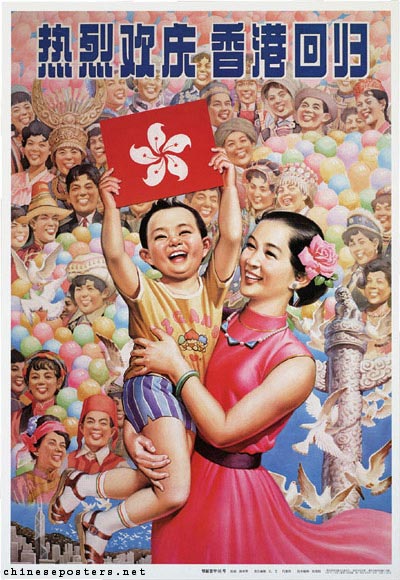
1997 - Enthusiastically celebrate the return of Hong Kong
Agreed to in 1984, the return of Hong Kong from British control had been long awaited. Those were the days of Maggie Thatcher's rule in Britain, and she was not inclined to "giving in" to the Chinese by handing back the colony, which legally was on a 99 year lease to Britain. After much debate with her ministers, Maggie gave in and agreed to the return of the entire colony in 1997, including some 8% of the territory which was legally British in perpetuity, not part of the lease. Per Deng Xiaoping's suggestion, the re-incorporation was done under the terms of the "One China, two systems" concept, whereby Hong Kong would retain control for 50 years of its economic and democratic system, as well as various peculiar traditions, such as driving on the left (as in Britain).
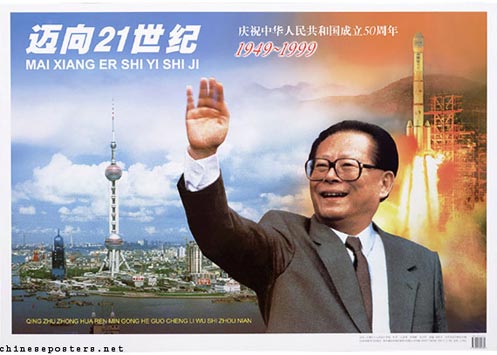
1999 - Advance into the 21st Century
Celebrating the 50th anniversary of the proclamation of the People's Republic of China, we find this remarkably ugly mash-up of photos, something which seem to be a trend. We've seen signs of this trend in earlier posters, particularly the "Only socialism can save China" poster and the one promoting Deng's southern investigation tour, and more are coming as we draw nearer to the present.
Good graphic designers know that blending different photos successfully into a single design requires great skill and care. In a painting, the artist has a lot of latitude when it comes to his depiction of something. Even if it's realist/naturalist in style, as many of the previous Chinese posters are, the viewers immediately know that they're looking at a painting, not an actual real-life situation. Photos however, are supposed to do just that, depict a piece of reality, however rehearsed it may be, and are viewed as such by the public.
Looking back at the posters I've presented in this series, you'll notice how often a poster artist has jammed together various symbols, items and people into one poster, without it appearing particularly problematic. Do a similar mash-up with photos, and you might end up with something like this, a look that is neither great nor awful nor mediocre. I find it mildly nauseating and just a little bit sleep-inducing. The wide range of fonts used, their colouring and placement does not help.
Oh by the way, the smiling fellow is Jiang Zemin, paramount leader in China from 1993 to 2004, when he was succeeded by the current head honcho, Hu Jintao.
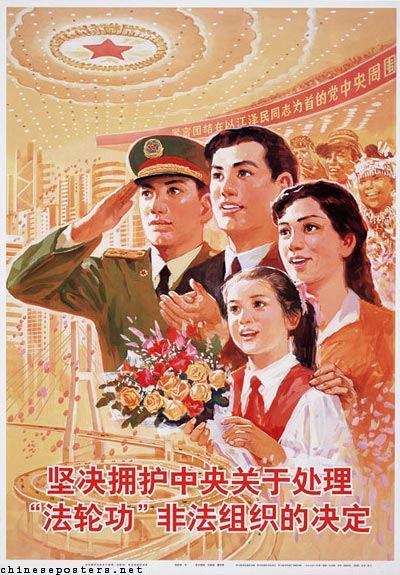
1999 - Firmly support the decision of the Central Committee to
deal with the illegal organization of "Falun Gong"
Disregarding the contemporary theme, as well as the ugly, outlined text, this looks like something straight out of the 60's, though I'd say the general quality of the design here is inferior to what I've seen from what you'd find back then. The woman looks rather like the somewhat obscure Irish-American actress Moira Kelly.
As I've understood it, the whole Falun Gong situation in China is a tragic result of the communist party's fear of any grouping of people arising outside of sanctioned party organizations. In an un-democratic one-party system where the government seeks to keep public opposition down, the rise of a huge, religion-like movement outside of sanctioned party organizations is a potential threat. The Chinese government in 1998 estimated that there were 70 million Falun Gong practitioners in China. The fear was that if these were to build on what they already had in common, the Falun Gong could become a dangerous threat to the communist party and its rule in China.
Not prepared to run that risk, the party has struck down hard on Falun Gong practitioners, with reports of widespread use of violence, torture, imprisonment and forced labour. Manfred Nowak, UN Special rapporteur on torture, reported in 2006 that 66% of alleged torture victims in the People's Republic were Falun Gong.
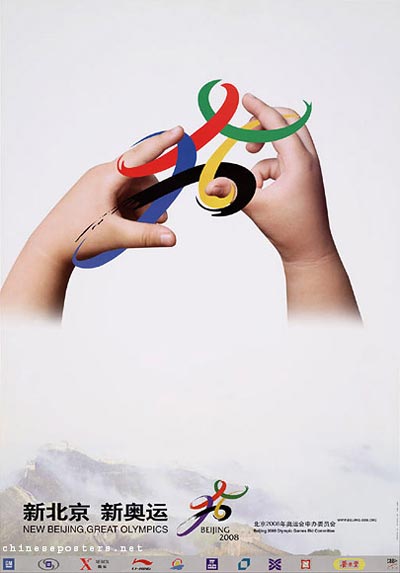
2000 - New Beijing, Great Olympics
Upon naming China the host of the 2008 summer olympics, some claimed it was reprehensible to award this symbol of peace and friendship to a country with such a shabby human rights record. Others suggested that the olympics be a way of influencing China in the right direction, that the olympics would be a sort of conduit for the respect for human rights.
In any case, it's a recognition of the new China which has arisen in the last decades out of well over a century of devastating warfare, humiliating colonialism and general mayhem. While I'm personally sceptical of claims that the People's Republic will surpass the United States as the greatest power in the world any time soon, there's no doubt that the ancient country is moving back towards its traditional place in the world, as "the middle kingdom", or republic to be more contemporary.

2001 - The Chinese Communist Party represents throughout the requirements in the development of advanced productive forces in China
Another example of a hideous photo collage poster. This techy piece jumbles together amongst others a high-speed train, various spacecraft, some DNA and a lot of binary code. As a bizarre contrast, blazing above it all, we find a shiny hammer and sickle floating on a sea of... pink?
I have no clue as to why the artist has chosen two shades of pink as the dominating colour for this poster, it's certainly not a colour you usually associate with the communist hammer and sickle. To be honest, I rather like it. Whether it's because it is quite acceptable in contrast to the awful jumble in the posters lower half, or if it's because I have too many female friends, I do not know. Regardless, I give my stamp of approval for more pink communist propaganda!
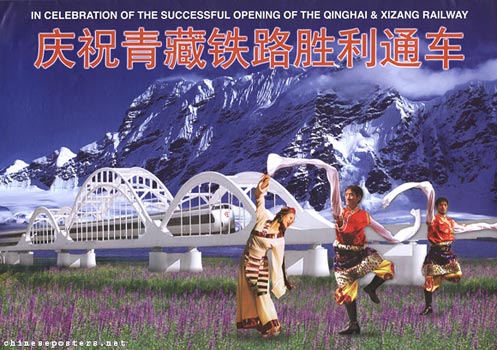
2006 - In celebration of the successful opening of the Qinghai & Xizang railway
Xizang is the Chinese word for what's known as Tibet in english. This poster then, commemorates the completion on July 1st of 2006 of the railway connection between Qinghai province in China and Lhasa, the capital of the Tibetan Autonomous Region. Crossing higher altitudes than any other railway, and difficult terrain, including the imposing Kunlun mountains, it's an engineering feat of no mean order, so you might expect it to be a cause for celebration.
The communist party agrees, adding that it will facilitate economic development to remote Tibet. Critics, such as Humans Rights Watch, claim it's a step towards marginalizing the indigenous Tibetans by easing the influx of ever greater numbers of Han Chinese, as to make the Tibetans a minority in their own land and consolidate Chinese control in the area. The Dalai Lama has stated that "some kind of cultural genocide is taking place", carrying on to explain that the railway is politically motivated to bring about demographic change.
Want more? Catch up on part 1 and part 2 of the series.
